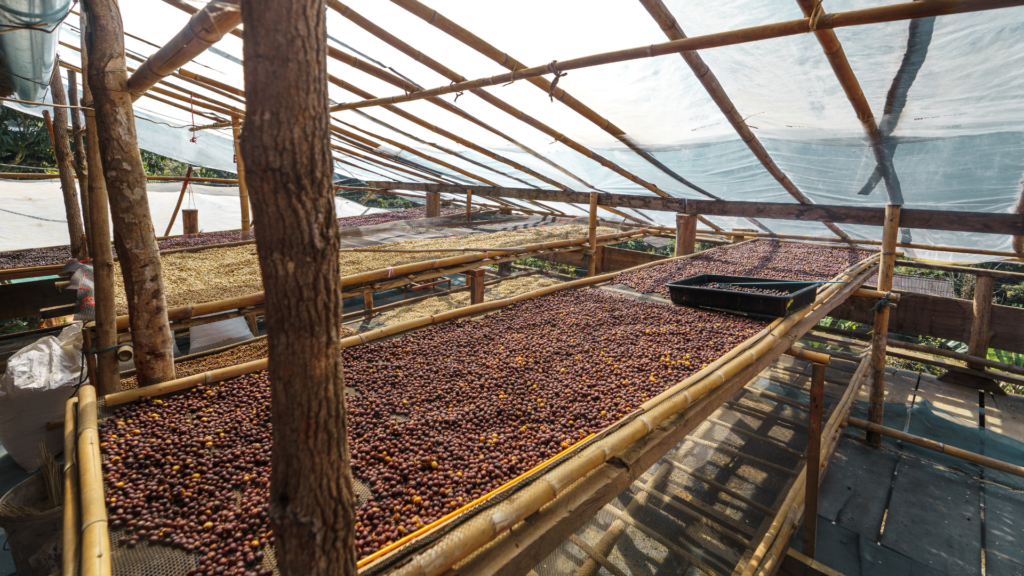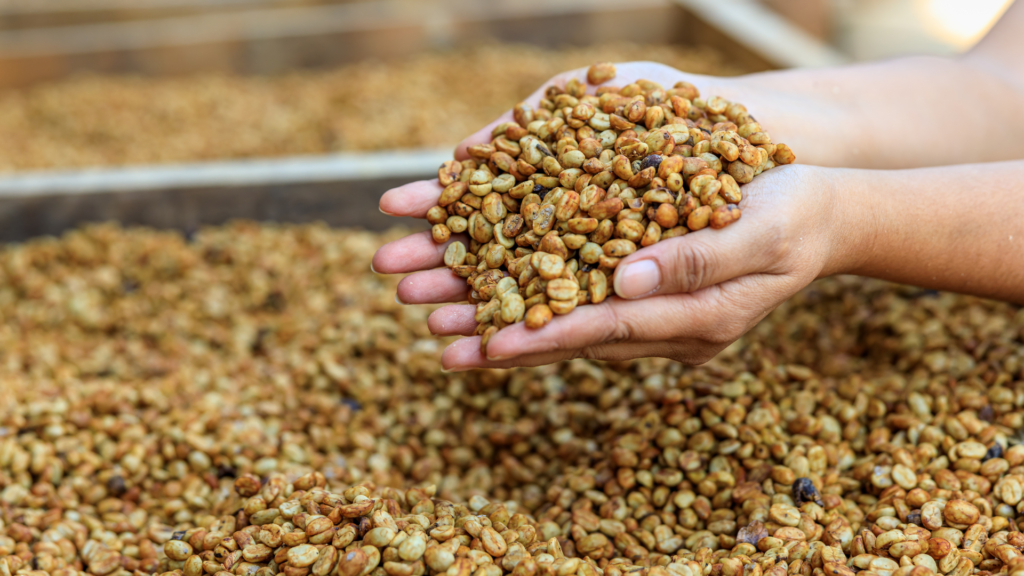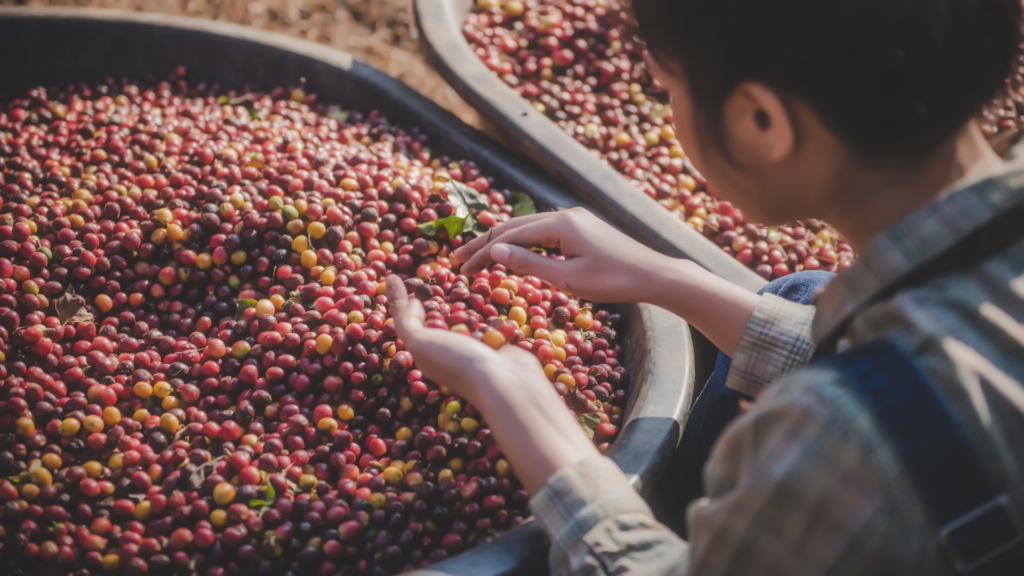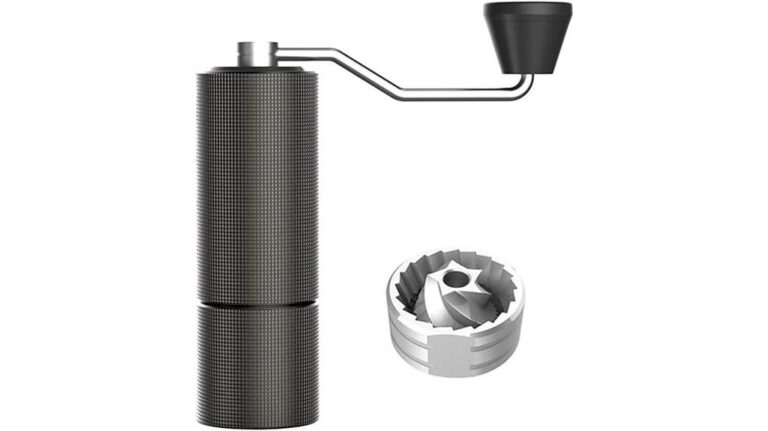The Art And Science Of Coffee Processing
Coffee, a beverage revered globally for its rich flavors and stimulating properties, begins its journey as a cherry-like fruit growing in clusters along the branches of the coffee plant. The path from these vibrant cherries to the aromatic beans we grind for our morning brew is shaped significantly by a crucial, often overlooked stage: coffee processing.
This initial stage of transforming raw coffee cherries into dried coffee beans is not just a necessary step in coffee production; it’s an art form that profoundly influences the final taste profile of the coffee.
‘Coffee processing’ refers to various methods of removing the coffee bean from the cherry and preparing it for roasting. Each method has its own unique set of steps and conditions, whether it’s the traditional washed process, the natural or dry process, honey processing, or the innovative fermented techniques. These methods significantly affect the bean’s ultimate flavor, acidity, body, and aroma.
Washed Coffee Processing

Washed coffee, also known as wet-processed coffee, is renowned for its clarity and purity of flavor. This method, prevalent in regions with abundant water resources, is a meticulous process that plays a significant role in highlighting the intrinsic qualities of the coffee bean.
At its core, washed coffee processing involves removing the coffee cherry’s outer layers to expose the coffee bean, which is then fermented, washed, and dried. This method is preferred for producing a clean cup with pronounced acidity and complexity.
Their clarity and pronounced acidity often characterize washed coffees. They have a cleaner, more consistent flavor profile with bright, crisp notes. These coffees can showcase a range of flavors, from floral and citrusy to sweet and nutty, depending on their origin.
Washed processing is widely practiced in countries with abundant water resources and specific environmental conditions. It’s prevalent in Central and South America, Africa, and Asia. Each region brings unique characteristics to the washed coffees, influenced by factors like altitude, soil type, and climate.
The washed process, focusing on purity and clarity, offers a unique window into the natural flavors inherent in coffee beans. It sets a standard against which other coffee processing methods are often compared.
The Washed Coffee Process
- Picking: The process begins with the selective handpicking of ripe red coffee cherries. This selective picking ensures that only the cherries at the peak of ripeness are processed, which is crucial for quality.
- Fermenting: After de-pulping, where the outer skin and some of the pulp are removed, the beans, still coated in mucilage, are fermented. Fermentation can be either dry or wet and typically lasts between 12 to 48 hours, depending on the climate and altitude. This stage is critical as it helps break down the sugars in the mucilage and develops the bean’s intrinsic flavors.
- Washing: Post-fermentation, the beans are thoroughly washed with large quantities of water to remove the mucilage. This step is vital for stopping fermentation and ensuring a clean flavor profile.
- Drying: The washed beans are then spread into thin layers to dry on raised beds or patios. Drying must be done carefully to avoid over-fermentation or mold growth. The goal is to reduce the moisture content to 10-12%.
Weird Coffee Tip: The way coffee is processed is part of the greater farming process. The way coffee beans are processed significantly impacts farming methods and can affect the sustainability of the product. To learn more about sustainable and organic coffee farming methods, take a look at this article:
Organic Coffee Farming Methods
Natural/Dry Processed Coffee

Natural processing, also known as the dry process, is one of the oldest methods of coffee processing. It is renowned for producing coffees with rich, bold, and often fruity flavors. This method is prevalent in regions with limited water resources and significantly impacts the bean’s final flavor profile.
This coffee bean processing involves drying coffee cherries with the bean still inside the fruit. This method is less resource-intensive than the washed process and is known for its simplicity and environmental sustainability. The interaction between the bean and the drying cherry imparts unique flavors different from those in washed coffees.
Naturally processed coffees are known for their full body, rich texture, and pronounced sweetness. They often exhibit various flavors, from berry-like and winey to chocolatey and spicy. The natural process allows the beans to absorb sugars and other compounds from the fruit, resulting in a distinctively fruity and sometimes wild flavor profile.
This type of processing is particularly prevalent in regions where water is scarce, such as parts of Ethiopia, Yemen, and Brazil. In these areas, the natural process is not just a matter of flavor preference but also a practical adaptation to the local environment. The tradition of natural processing in these regions contributes to the distinctive character of their coffee offerings.
Natural processed coffees starkly contrast with washed coffees, providing a more robust and fruit-forward flavor experience. This method’s reliance on natural elements and traditional techniques highlights the diverse ways coffee processing can influence the final cup.
The Natural Processing Method
- Picking: Similar to washed processing, the natural process starts with harvesting ripe coffee cherries. The quality of the final product is heavily dependent on picking cherries at the optimal stage of ripeness.
- Drying with Fruit on the Bean: After picking, the whole cherries are spread out in thin layers to dry, typically on raised beds or drying patios. This drying phase is crucial and can last several weeks. During this time, the cherries are regularly turned to ensure even drying and prevent mold or fermentation defects.
- Hulling: Once the cherries are thoroughly dried and the moisture content reaches the desired level, the dried outer fruit is mechanically removed, leaving behind the green coffee beans.
Honey/Pulped Natural Process

The honey and pulped natural processes represent a fascinating middle ground between the washed and natural methods. It’s a technique that has gained popularity for its ability to produce coffees with a unique balance of body, sweetness, and acidity. This method is named for its sticky, honey-like mucilage that coats the beans during drying.
Honey processing begins by removing the outer skin of the coffee cherry, similar to washed coffee, but leaves some or all of the mucilage (the fruity layer) on the bean while it dries. This partial removal of the cherry, combined with the drying process, results in a coffee that shares both washed and natural coffee characteristics.
Coffees processed in this way are known for their balanced profile, combining the clean acidity of washed coffees with the sweet, full-bodied character of natural coffees. The level of mucilage left on the bean during drying directly impacts the final cup’s sweetness, body, and complexity.
The honey process is particularly popular in Costa Rica, Guatemala, and Brazil, where innovative producers constantly explore variations to create unique flavor profiles.
By bridging the gap between washed and natural methods, honey processing offers a unique perspective on how mucilage influences the taste and texture of coffee. This method’s flexibility and the resulting diversity in flavor profiles make it an exciting area of exploration in the coffee world.
The various types of honey processing include:
- White Honey: Minimal mucilage left, resulting in a cleaner, more washed-like profile.
- Yellow Honey: A moderate amount of mucilage that balances sweetness and acidity.
- Red Honey: More mucilage is left on the bean, enhancing body and sweetness.
- Black Honey: The most mucilage left on, requiring careful drying, results in a rich, bold flavor.
The Honey Processing Method
- Picking: As with other methods, selecting ripe cherries is crucial. The quality of honey-processed coffee is highly dependent on the initial cherry selection.
- Removing Skin and Pulp: The cherries are de-pulped, but unlike washed processing, not all mucilage is removed. The mucilage left on the bean can vary, influencing the coffee’s final flavor.
- Drying with Mucilage: The beans, still coated with mucilage, are laid out to dry. This phase is critical and requires careful monitoring to prevent over-fermentation or spoilage. The sticky beans are often turned more frequently than in natural processing.
- Hulling: After reaching the desired moisture content, the beans are hulled to remove any remaining dried mucilage and parchment.
Fermented Coffee Processing

Fermented coffee processing is a cutting-edge approach gaining traction among coffee producers for its ability to create distinctive and complex flavor profiles. This method involves intentionally controlling the fermentation of coffee beans to develop unique flavors, often with surprising and delightful results.
Fermentation in coffee processing is not new; it’s a natural part of both washed and natural methods. However, fermentation is not just a step in the process but the focal point in fermented coffee processing. Producers manipulate variables like time, temperature, and the presence of specific yeasts or bacteria to influence the coffee’s final flavor.
The flavors developed through these specialized fermentation techniques can be quite diverse. They often include pronounced fruity notes, complex acidity, and a depth of flavor significantly different from traditional processing methods. These flavors are not just the result of the coffee cherry’s inherent qualities but also the byproduct of the fermentation process itself.
Fermented coffees are being produced in various parts of the world, including Central and South America, Africa, and Asia. Each region and producer brings their unique approach to fermentation, resulting in a wide range of flavors and styles. For instance, some Ethiopian producers are known for their naturally fermented coffees that exhibit wine-like and berry flavors. At the same time, in Central America, experimental anaerobic fermentation creates coffees with unique, bold profiles.
While fermented coffee processing offers exciting possibilities for flavor development, it also presents challenges. The process requires precise control and understanding of fermentation, and there’s a higher risk of producing off-flavors if not managed correctly. However, it can elevate the coffee experience to new heights when done well.
Different Fermentation Techniques
- Wet Fermentation: Similar to the traditional washed process, but with a controlled fermentation stage where temperature and pH are closely monitored.
- Dry Fermentation: This method involves fermenting the whole cherry or the bean with some mucilage in a controlled environment, often resulting in more pronounced fruit flavors.
- Anaerobic Fermentation: Beans are fermented in a sealed, oxygen-deprived environment. This method can produce unique flavor profiles, ranging from intense fruitiness to complex wine-like notes.
- Experimental Fermentation: Some producers are experimenting with adding specific yeast or bacteria strains to influence the fermentation process further, aiming to create consistently unique flavor profiles.
Other Innovative Coffee Processing Methods
In addition to the traditional and fermented processing methods, the coffee industry continues to innovate, experimenting with new techniques to enhance flavor complexity and diversity. These experimental methods are part of a growing trend that combines scientific understanding with traditional practices, pushing the boundaries of coffee flavor profiles.
Anaerobic Fermentation
Anaerobic fermentation takes the traditional fermentation process a step further by restricting oxygen exposure. Beans are fermented in sealed tanks, creating a unique environment that influences the chemical reactions during fermentation.
This method can produce various flavors, from pronounced fruity and wine-like notes to unexpected savory and spicy undertones. The lack of oxygen leads to different metabolic processes in the beans, resulting in these distinctive flavors.
Carbonic Maceration
Inspired by techniques used in winemaking, carbonic maceration involves fermenting the coffee cherries in a carbon dioxide-rich environment.
This method enhances the fruity characteristics of the coffee and can create a more pronounced acidity and sweetness. It often results in a distinctive cup profile with bright, vibrant flavors.
Conclusion
Coffee processing is more than just a necessary step in coffee production; it’s a crucial factor in determining the flavor, body, aroma, and overall quality of the coffee.
Washed coffees bring clarity and acidity, natural coffees offer bold fruitiness, honey-processed coffees strike a delightful balance, and fermented and experimental coffees push the boundaries of flavor. Understanding these processes deepens our appreciation for the coffee we drink and the people who produce it.
Coffee processing is an ever-evolving field, rich with tradition and ripe for innovation. As we continue to explore and understand the myriad ways coffee can be processed, we open ourselves to a world of flavors, experiences, and knowledge.
The future of coffee processing is not just about producing a commodity but about crafting an experience that respects the environment and elevates the coffee drinker’s experience.
-
Espresso Express eBook
R180,00 -
From Bean To Brew eBook
R450,00 -
Great Coffee, Made Simple
R0,00









